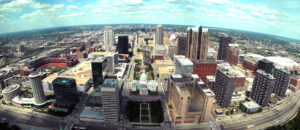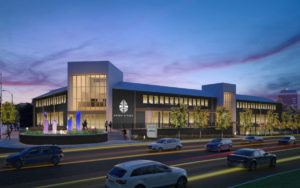How Green Street is Repurposing St. Louis
How Green Street St. Louis is working with entrepreneurs to move St. Louis' existing infrastructure forward.
Positioning matters—and for startups, everything from the mission statement to customer support is scrutinized. But all too often in a digitally-driven, co-working friendly age, a company’s physical location is an afterthought.
Location and space are opportunities many entrepreneurial companies miss, but that doesn’t have to be the norm. Case in point: Some entrepreneurial firms are finding real estate that more than meets their needs—it helps them reach their goals. This is something Avatara, a St. Louis-based IT company, recently discovered.

Their experience seeking entrepreneur-friendly real estate proves innovators have the option to find a location and space that’s adaptable to a growing company. And Green Street’s partnership with Avatara and Arcturis illustrates how a team of developers, architects and tech entrepreneurs can join forces to cultivate a thoughtfully creative community.
The Next Step
The collaboration began at a pivotal time for Avatara, a decade-old company, founder and CEO Rob McCormick explained. Their next steps needed to be establishing ones, where they could more visible and find what he calls a “permanent identifying space.”
“A lot of people who are in the incubators are loosely defined and are getting a lot of shared resources and shared technology capability,” McCormick says. “So eventually they are ready to ‘graduate’ out of that and become a standalone, viable company. And what does a standalone viable company want? They want their own identity.”
To manifest theirs, Avatara partnered with Green Street primarily because they share a vision of revitalizing St. Louis. Green Street concentrates on redeveloping urban properties in the city, specifically within the central corridor originating in the Grove towards Downtown then north on Jefferson Boulevard. Their work includes buildings for Urban Chestnut’s Grove location and Dynalabs on Chouteau.
The portfolio the development company curates is purposefully geared toward entrepreneurs to fill the needs created both by St. Louis’ startup wave and the fallout of the city’s corporate restructuring.
“The entrepreneurial ecosystem is developing, but the physical world where that ecosystem operates hasn’t caught up yet,” Brian Pratt, Green Street’s executive vice president, says. “The way we create buildings and repurpose buildings is to provide a kind of physical element to the change in our [St. Louis] economy.”

Coming Together
The space Avatara and Green Street settled on was at 2329/2351 Market St. Green Street hired Arcturis shortly after they bought the building, months before Avatara’s lease was finalized.
The St. Louis-based architecture firm had already established themselves in the startup space in their work within the Cortex Innovation District and for the CIC@CET building.
Soon after Arcturis came on board, a new consideration emerged: Avatara’s business needs included more than ambiance and autonomy.
“What we wanted to do here was not only have a big open place that was extremely functional to work in as teammates, but we also needed access to connectivity and high, huge amounts of bandwidth,” says Ben Scully, Avatara’s chief marketing officer. “We wanted to leverage what we do with technology as a tech company.”
Phil Hulse, founder and managing principal at Green Street, took notice and wondered, “Why can’t we take what they are doing for Avatara and apply it to future clients of Green Street?” It was an opportunity to inject a new way of thinking across a broad range of projects.

The team created Avatara’s office to be a “tech-enabled space”—a term that Avatara, Arcturis and Green Street co-coined (and now incorporate into their services).
Each party has a nuanced definition, but Megan Ridgeway, principal at Arcturis, defines it as “the creation of an environment, through the application and availability of technology, for people to work and learn more with a great degree of flexibility and mobility—with no compromise on the reliability, security or availability of access to data and communication channels.”
By having a space prepped for connectivity, entrepreneurs’ capital and time can go directly into their core business operations rather than spending precious time and capital on infrastructure and equipment. It also gives them the flexibility to adapt and scale as they grow their business.
For Avatara, the results of operating out of a well-designed, tech-enabled space go beyond aesthetics and infrastructure: “It’s really cemented who we are as a company and allows us to work more efficiently and effectively,” says Scully. It’s enabled them to streamline their work processes, meet customer demand, and stand out from competitors.
But the vision for tech-enabled spaces doesn’t end here. Moving forward, Green Street has larger plans for the entrepreneurial community and for St. Louis: They aspire to build out closely located developments, to construct dynamic buildings and to nurture entrepreneurial communities. Alleviating logistical hurdles for entrepreneurs can only help the progress of the city—just what Green Street, Arcturis, and Avatara set out to achieve.
What Exactly is Tech-Enabled Space?
A tech-enabled space anticipates and plans for the technical needs required to operate a business. These spaces have services integrated into their designs during the formative stages of the project. Ideally, companies moving into tech-enabled spaces can “plug and play”—in other words, they can hit the ground running.
A few examples of what kinds of tech goes into these spaces:
- Gigabit fiber bandwidth
- Wi-Fi
- SSAE 16 data center rack space
- Backup servers
- File storage servers
- Application servers
- Hosted email
- Hosted security
- Cloud desktops
- Fully managed services
The layout and flow of the location is designed with technology in mind—along with adaptability, as both the company’s needs and technology evolve. But aesthetics are still important: No one wants to work in a high-tech bunker, so traditional architectural elements (lighting, ceilings, etc.) are still carefully considered and crafted.



